

- #Vnc connect vista install
- #Vnc connect vista drivers
- #Vnc connect vista free
- #Vnc connect vista windows
Yes, this rate is on the x11vnc side (VNC server), and is a rate local to that computer (i.e. what is the rate at which pixels rendered in the graphic hardware's framebuffer memory (Video RAM) can be read back into the computer's main memory (main RAM, where x11vnc accesses it.) When you talk about the graphics card's read rate, is that referring to the graphics card in the server computer or the viewer computer? The fact that you are referring to this in relation to x11vnc, makes me think it may be the server computer's read rate to which you refer- but then the server computer is sending and the viewer computer is reading, so it doesn't completely make sense that one would be concerned about the read rate on the sending computer.Ī better term I have seen used (and should use myself) is 'readback rate'. Search these forums for 'x11vnc forever' and I think you'll get some useful ideas. Perhaps there is a 'xclients' or 'startup' script you can add the x11vnc command to. It is the '-forever' option that keeps it waiting for more connections. My system is setup so that tty2 uses autologin and "startx" is executed using. How can I get x11vnc to always run in the background and not exit after I disconnect a vnc session? I think going back to a normal window manager would allow x11vnc to work with XDAMAGE (this gives a nice performance improvement.) The main problem seems to be the X server's interaction with the (very silly IMHO) compiz/beryl, etc.
#Vnc connect vista free
Feel free to add yourself to the bug report. It is unfortunate that Xorg hasn't fixed this bug going on 3 years now. I've tried the -noxdamage parameter and it solved my problem!
#Vnc connect vista windows
Do you have a 2nd Linux machine you could run the viewer on as a test? Maybe boot the windows machine with a Linux live-cd? I hope the problem is the xdamage bug.īTW, in the past I have noticed slower than expected response running vnc viewers on Windows machines over a LAN. You probably don't need to play with that, but you can if nothing else works. I'm using RealVNC on Windows Vista to connec to x11vnc and I have the encoding set to "Auto select" (and ZRLE is an available option so it should work.?) I did a test and it seems a bit faster than ZRLE (but it uses a lot of bandwidth.)Ĭan somebody check my log file? It's located here: Ĭan you define and quantify which activities are slow, your estimate how long they are taking, etc.? Thanks. Using Nvidia drivers, correct?Ģ) It appears as though I'm using ZRLE encoding but for some reason it switches to hextile. That's a good read rate, so it shouldn't be the problem. I'll try "-noxdamage" when I get home but noticed two things from my logfile:
#Vnc connect vista drivers
Also, if one must use Xorg drivers and he doesn't care much for very fast local performance, he can set the ShadowFB option in nf. Nvidia drivers can be 400+ MB/sec and this makes a very big different for LAN usage. it takes 0.5 seconds to read in a single 1280x1024x32 screen, so the most you could expect is 2 of those frames per second. Most Xorg drivers are slow like the above (10 MB/sec). Please post what it prints out for your card. X11vnc prints out how fast your read rate is:

How fast is your graphics card's read rate? (not write rate) I've checked my RealVNC settings and it's only requesting low color (8 colors) and it's definitely not a bandwidth issue since I'm on a gigabit lan so what else is going on?
#Vnc connect vista install
I'm new to Ubuntu (and Linux) but I've installed x11vnc (sudo apt-get install x11vnc) and then I run "x11vnc -display :0 &" to start the server.Īfter that I use RealVNC VNC Viewer on my Windows Vista machine to connec to x11vnc and it works but it's incredibly slow.


 0 kommentar(er)
0 kommentar(er)
